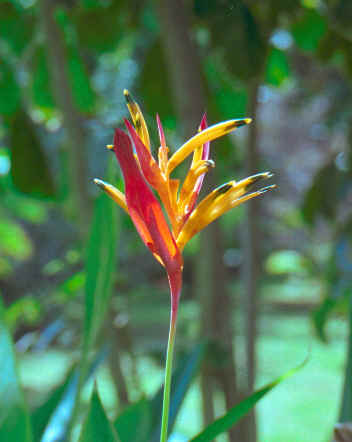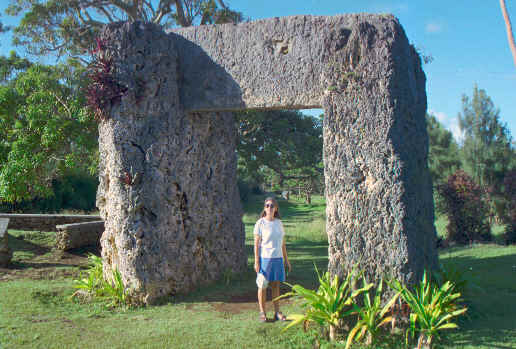| Edi and Almuth of SINGLE MALT, a Swiss boat, called on the VHF radio and wanted to share a taxi for an island tour, starting around 1030 so we agreed to go. Poor Edi had been helping another boat with some drilling and had wanted to take a shower up at the washrooms. Unfortunately the water ran out just as he had got soap in his hair, so he spent the whole day with a soapy head. Later we found out that there is a switch for the water which you have to turn on. We finally got going just around 1100 with a taxi driver named David. |  |
We went out towards the west of the island first, stopping in Kolovai to see the Flying Foxes which were hanging in trees beside a cemetery, at a monument marking the location where Christian Missionaries first landed, and at the Abel Tasman monument commemorating the European discovery of the islands. Tongan roads are very basic, although paved, without centre or side stripes, and driving is on the left side of the road. Cars are almost all Japanese. The speed limit is 40 km in the villages and 65 elsewhere, and the police use radar.
 |
Stuffed and a bit sleepy after a very good lunch, we headed for the blowholes on the south coast of the island. These were spectacular.. As the waves hit the wide limestone ledges the water is forced up through breaks in the rock and holes of the underwater caves. Large waves forced geysers of spray high into the air accompanied by a sound similar to that made by spouting whales. All of us were quite overwhelmed by the beauty and power of nature’s display. |
From there we headed off to the Bird Park, a Tongan Wildlife Centre that has breeding programs to save threatened Tongan bird species. We saw at least five of the Red Shining Parrots which they have been attempting to breed here and several cute Blue-Crowned Lorikeets, which were quite curious and friendly. Lorikeets are disappearing on islands where roof rats have been introduced as the rats climb into their nests and eat eggs, chicks and even adults. Other cages contained examples of the pink breasted Pacific Pigeon, which we saw in Vava’u, Grey Ducks (the first ducks we’ve seen since Mexico I think), a Purple Swamphen, a pair of Banded Rails and, sitting all by itself at the top of a branch, a Common Barn Owl with white face and dark eyes. We were also lucky enough to spot one of the Tongan Megapodes hiding in the back of its cage. These bird live on the northern island of Niuafo’ou which has an active volcano. There they bury their eggs communally in warm volcanic soil, up to 1.5 meters deep, where the eggs are incubated by the warm sand. The chicks eventually hatch, fully developed with feathers, etc., dig out to the surface and then look after themselves. I was quite revolted by a display of predators on the chicks which included an ant which blinds the chick just as it emerges by biting its eyes, making it quite helpless, and then proceeds to feed on the living chick. Ugh.
 |
 |
The park also has a display of local ornamental plants,
agriculturally important plants and threatened plants with signs explaining the
traditional uses of some examples.
After the bird park we wanted to go to the beach cave. It was pretty obvious that David
did not want to go there and said that we could not go without lights, but we had all
brought flashlights so off we went. Unfortunately it developed that he could not remember
exactly where they were and we had a couple of false starts before we found the right
place. At one of our false starts however, we found a very interesting area which had
concrete sofas and extensive stone stairways and fale bases. It seems to have been
a resort which failed. There is not beach in this area of the island as it is on the
exposed east coast, but it has a great view of Eua, a large island east of Tongatapu.
The cave was a bit scary as we are not too fond of caves. There is a little concrete block
building at the entrance and some concrete stairs and old handrails (now rusted away) so
presumably at one time this was more of an attraction and perhaps money was charged to
enter, but now it seems quite abandoned. Paula was so nervous, she forgot to take her dark
glasses off the entire time we were inside the cave, so saw very little. There were small
bats in the cave, making clicking sounds as they flew around in the dark, and also
swiftlets which twittered at us angrily. A large central column of limestone supporting
the ceiling was cracked, perhaps due to earthquakes. We did not stay long. There are steps
carved into the limestone heading off deeper into the cave at the back as well as more
steps made out of concrete blocks leading down to a pool. Our flashlights were nor
powerful enough to properly view the cave and we did not want to explore very deeply
anyway. Other more intrepid cruisers went deeper into the cave to another pool for a quick
swim.
| Next stop was the trilithon on the eastern point of Tongatapu, the Ha’amonga’a Maui, an arch made from three blocks of non-stratified limestone. The Tongan name means the burden of the god Maui, as he was supposed to have carried the stones here from Wallis Island using the central lintel as his carrying pole. No one knows exactly when it was built or for what purpose. Some say it has to do with telling seasons based on grooves in the limestone, but our guidebook says that these grooves are believed to have been cut long after the trilithon was erected. Nearby there is a large standing stone (2.7 meters) which is believed to have been the backrest of the 11th Tui Tonga, Tu’iatui. |  |
On the way back, at Vlads request, we stopped briefly at
Lapaha to see the langi or tombs. Lapaha was the ancient capital of Tongatapu and
there are extensive burial mounds. Our guidebook says that these rank in archeological
significance with the ruins at Maeva on Huahine, but they are very overgrown as Tongan
culture does not permit them to be either excavated or even cared for. The double rows of
coral slabs on the facings of the mounds reminded us strongly of the marae in
Huahine.
The tour cost us T$45 per couple which was not bad. Our only caution would be that it is
really worth getting a driver who speaks good English and is interested in giving you a
good tour. We started late, which was our fault, but felt that David just did not know
enough about the island history to give a really good tour. He also wanted to skip things
like the burial sites (and the caves) perhaps due to the time or perhaps because he just
wanted to hit the highlights. We would not have stopped at the Bird Park if we had not
specifically asked to and we only saw the Abel Tasman monument because Paula insisted and
had the tour map from the Visitor’s Bureau.